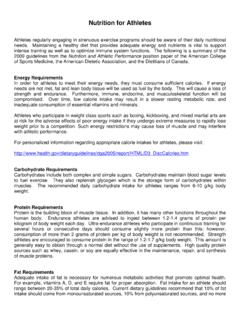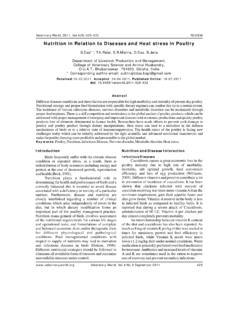Transcription of Diet, nutrition and the prevention of excess weight …
1 diet , nutrition and the prevention of excess weight gain andobesityBA Swinburn1,*, I Caterson2, JC Seidell3and WPT James41 Physical Activity and nutrition Research Unit, School of Health Sciences, Deakin University, Melbourne, Australia:2 Faculty of Medicine, University of Sydney, Sydney, Australia:3 Free University of Amsterdam, Amsterdam,The Netherlands:4 International Obesity Task Force, London, UKAbstractObjective:To review the evidence on the diet and nutrition causes of obesity and torecommend strategies to reduce obesity :The evidence for potential aetiological factors and strategies to reduce obesityprevalence was reviewed, and recommendations for public health action, populationnutrition goals and further research were :Protective factors against obesity were considered to be: regular physicalactivity (convincing); a high intake of dietary non-starch polysaccharides (NSP)/fibre(convincing); supportive home and school environments for children (probable); andbreastfeeding (probable).
2 Risk factors for obesity were considered to be sedentarylifestyles (convincing); a high intake of energy-dense, micronutrient-poor foods(convincing); heavy marketing of energy-dense foods and fast food outlets(probable); sugar-sweetened soft drinks and fruit juices (probable); adverse socialand economic conditions developed countries, especially in women (probable).A broad range of strategies were recommended to reduce obesity prevalenceincluding: influencing the food supply to make healthy choices easier; reducing themarketing of energy dense foods and beverages to children; influencing urbanenvironments and transport systems to promote physical activity; developingcommunity-wide programmes in multiple settings; increased communications abouthealthy eating and physical activity; and improved health services to promotebreastfeeding and manage currently overweight or obese :The increasing prevalence of obesity is a major health threat in bothlow- and high income countries.
3 Comprehensive programmes will be needed to turnthe epidemic healthOverweightObesityEvidence-baseThis review paper has been structured to provide anoverview of the likely aetiological factors in thedevelopment of weight gain and obesity, to proposerelated population nutrient goals and content areas forfood-based dietary guidelines, and to evaluate some of thepotential food and diet related intervention strategies thatmight help to attenuate and eventually reverse this globalepidemic. The process involved Medline searches onrelevant topics determined by the authors and theparticipants in the Joint WHO/FAO Expert Consultationon diet , nutrition and the prevention of chronic diseases(Geneva, 28 January 1 February 2002). Recent reviewsand key papers were sought, but this did not involve a fullsystematic review on each level of evidence that a dietary factor could beinvolved in the promotion of or protection against thedevelopment of obesity was assigned on the basis of theevidence review and the weighting of this evidence bythe authors and Expert Consultation members.
4 Theevidence judgments were based on the framework anddefinitions used by the World Cancer Research Fund andAmerican Institute for Cancer Research in their review ondiet and cancer1. The evidence in that report was rated asconvincing, probable, possible or insufficient for apositive, a negative or no relationship between thevariable and cancer. However, because their outcome ofinterest was cancer, the framework mainly centred onepidemiological studies. In the current review, random-ised clinical trials were given the highest ranking withconsistent results from several trials constituting convin-cing evidence. This is particularly important in therelationship between diet and obesity because of themajor methodological problems of dietary underreport-ing. Obese people tend to underreport more than leanpeople and the underreporting may be the greatest forhigh fat and high carbohydrate foods2,3.
5 Another difficultyqThe Authors 2004*Corresponding author:Email Health nutrition : 7(1A), 123 146 DOI: in rating evidence in relation to some of the potentialenvironmental causes of weight gain. For environmentalfactors, more associated evidence and expert opinion hadto prevail because of the absence of direct studies or trialsin the is important to note that this review on obesity hasnot covered the energy expenditure side of the energybalance equation in any depth. Physical activity is at leastas important as energy intake in the genesis of weightgain and obesity and there are likely to be manyinteractions between the two sides of the equation interms of aetiology and prevention . The role of physicalinactivity in the development of obesity has been welldescribed5and a recent report from the US Center forDisease Control and prevention summarises the evidencebase for a variety of interventions to increase physicalactivity at the population level6.
6 Also, a thorough reviewof weight control and physical activity has recently beenconducted by the WHO International Agency forResearch on Cancer and was also used as a basis forrecommendations on physical global situation and trendsOverviewThe prevalence of obesity is increasing throughout theworld s population. But the distribution varies greatlybetween and within countries. In the US, over the past 30years, the prevalence of obesity rose from about 12 20%of the population from 1978 to 19908. The UK hasexperienced an increase in the prevalence of obesity from7% in 1980 to 16% in 19958. Other countries, such as TheNetherlands, have experienced much smaller increasesfrom a low baseline of about 5% in the 1980s to about 8%in 19979. In Asia, the prevalence of obesity has rapidlyincreased.
7 In the last 8 years the proportion of Chinesemen with a body mass index (BMI).25 kg/m2has tripledfrom 4 to 15% of the population and the proportion inwomen has doubled from 10 to 20%10. Pacific populationshave some of the world s highest prevalence rates ofobesity. The proportion of men and women with a kg/m2in Nauru was 77% in 199411and for Pacificpeople living in New Zealand in the early 1990s theprevalence rates were about 65 70% obesity epidemic moves through a population in areasonably consistent pattern over time and this isreflected in the different patterns in low- and high incomecountries. In low income countries, obesity is morecommon in people of higher socioeconomic status and inthose living in urban communities. It is often firstapparent among middle-aged women.
8 In more affluentcountries, it is associated with lower socioeconomicstatus, especially in women, and rural communities13, sex differences are less marked in affluent countriesand obesity is often common amongst adolescents andyounger is an example of a country with well-documented changes in obesity prevalence as it under-goes rapid nutrition transition. There has been a rapidincrease in obesity where the prevalence among urbanmen with high incomes is about 10%, but still only 1% inrural areas. Women in all regions are generally moreobese than men and the prevalence for those on lowincome is still increasing. However, the rate of obesityamong women with high income is becoming stable oreven standard definitions of overweight (BMI$25kg/m2) and obesity ($30 kg/m2)havebeenmainlyderived from populations of European descent8.
9 However,in populations with large body frames, such as Poly-nesians, higher cut-off points have been with smaller body frames, such as Chinesepopulations, lower cut-off points have been proposed17and studies are being undertaken to evaluate appropriatecut-off points for a variety of Asian fat distribution (often assessed by the waistcircumference or the waist:hip ratio) is an importantindependent predictor of morbidity19,20. Although thisreview focuses on weight gain and the development ofoverweight and obesity, it is acknowledged that increasesin abdominal fatness (particularly, intra-abdominal fat)pose a greater risk to health than increases in fatnessaround the hips and limbs. In general, the causes of weightgain and abdominal weight gain are the same and it is thecharacteristics of the individuals (such as sex, age,menopausal status) that influence the distribution of thefat that is nutrition transitionThe increasing westernisation, urbanisation and mechan-isation occurring in most countries around the world isassociated with changes in the diet towards one of high fat,high energy-dense foods and a sedentary lifestyle8,21.
10 Thisshift is also associated with the current rapid changes inchildhood and adult obesity. Even in many low incomecountries, obesity is now rapidly increasing, and oftencoexists in the same population with chronic under-nutrition21. Life expectancy has increased due toadvancement in nutrition , hygiene and the control ofinfectious disease. Infectious diseases and nutrientdeficiency diseases are, therefore, being replaced indeveloping countries by new threats to the health ofpopulations like obesity, cardiovascular disease sharp decline in cost of vegetable oils and sugarmeans that they are now in direct competition with cerealsas the cheapest food ingredients in the world22. This hascaused a reduction in the proportion of the diet that isderived from grain and grain products21and has greatlyincreased world average energy consumption, althoughthis increase is not distributed evenly throughout theworld s Swinburnet populations become more urban and incomes rise,diets high in sugar, fat and animal products replace moretraditional diets that were high in complex carbohydratesand fibre21,22.













